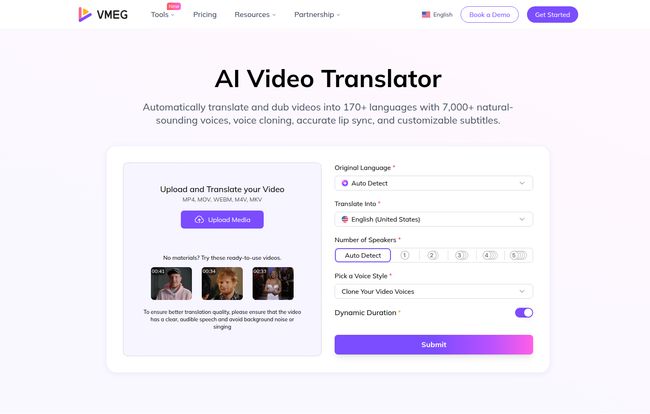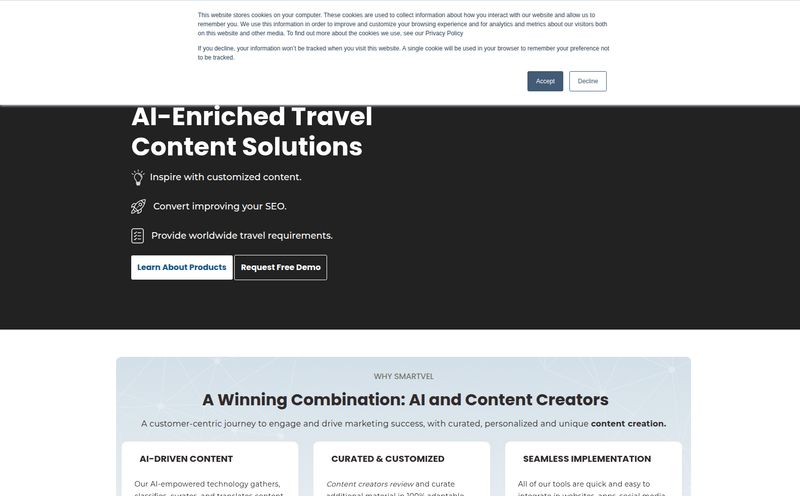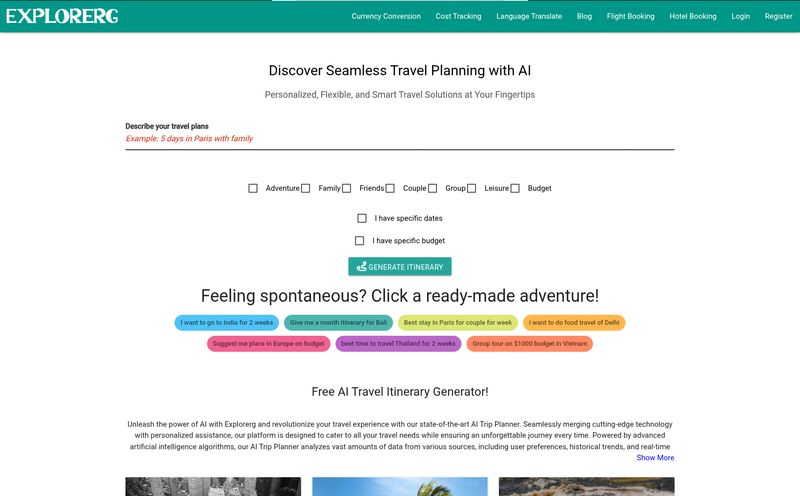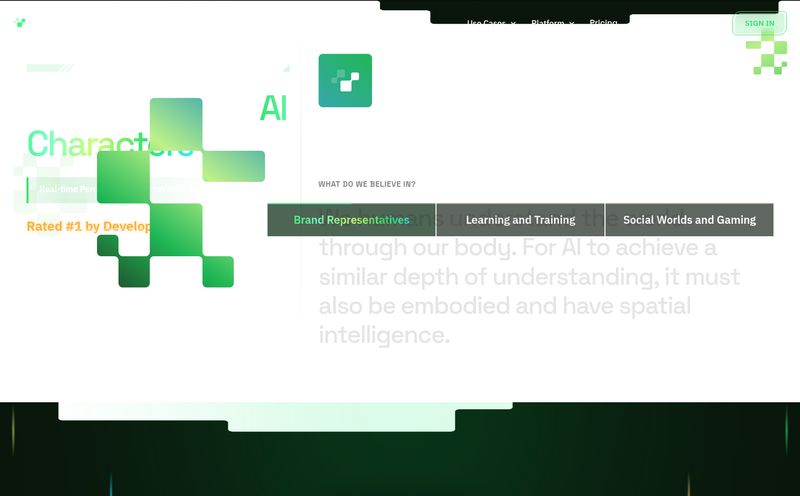For years, as content creators, we’ve been told to “go global.” It sounds great, doesn't it? Tapping into new markets, reaching audiences in their native language, becoming a worldwide sensation... The dream. But then reality hits you like a ton of bricks. The cost of hiring a professional dubbing studio, the logistical headache of finding the right voice actors for a dozen languages, the sheer time it takes. It's enough to make you just stick to English and hope for the best.
I’ve been there. I’ve priced it out. And frankly, it’s been a non-starter for most independent creators and even smaller businesses. But the tech landscape is shifting, as it always does. I’ve been keeping my eye on AI-powered solutions for a while, and I recently stumbled upon a platform called VMEG. It claims to automate the entire video localization process – translation, dubbing, subtitles, even lip-sync. Big claims. So, naturally, I had to see if it lives up to the hype.

Visit VMEG
First Off, Why Should You Even Care About Video Localization?
Before we get into the nuts and bolts of VMEG, let's just quickly touch on the 'why'. It's simple, really. People connect with content in their own language. A study by CSA Research found that 76% of online shoppers prefer to buy products with information in their native tongue. While they weren't talking specifically about YouTube videos, the principle is exactly the same. If someone can understand you effortlessly, without reading a wall of subtitles, they're more likely to watch, engage, and trust you. It's about breaking down barriers and making your content feel like it was made just for them.
Going multilingual isn't just a vanity metric; it's a genuine growth strategy. You're not just translating words; you're expanding your potential audience tenfold. Okay, sermon over. Let's get to the good stuff.
A Look Under the Hood: VMEG's Core Features
So what is this thing actually packing? It’s more than just a simple translator. It’s trying to be an all-in-one localization studio in a single browser tab. Here’s what caught my eye.
AI Dubbing with a Ridiculous Number of Voices
The headline feature is, of course, the translation and dubbing. VMEG boasts support for over 170 languages and accents. That's... a lot. But the real kicker is the library of over 7,000 AI voices. This isn't the robotic, monotone voice you remember from your old GPS. The goal here is to sound natural, with human-like inflections. You can even clone your own voice (on the paid plans), which is both incredibly cool and slightly dystopian. Imagine your own voice speaking fluent Japanese or Spanish. Wild.
Lip Sync That Actually Tries to Sync
This is the feature that made me raise an eyebrow. Bad dubbing is one thing, but when the mouth movements are completely off, it throws the whole video into the uncanny valley. It’s distracting and feels cheap. VMEG claims to have “next-generation lip sync” that adjusts the speaker's mouth movements in the video to match the new audio. If this works as advertised, it's a massive step up from just slapping a new audio track over the original video. It’s the difference between a professional-feeling dub and an obvious, jarring overdub.
Subtitles Without the Headache
I've spent more hours than I care to admit manually transcribing and timing subtitles. It's tedious work. VMEG automates this by generating subtitles from your video's audio and then translating those subtitles into other languages. This is a huge time-saver and a great feature for accessibility, not to mention for platforms like Instagram or TikTok where many people watch with the sound off.
So, Who Is This Tool Built For?
I can see a few groups getting really excited about this. It's not a one-size-fits-all thing.
- Content Creators & YouTubers: This is the obvious one. The ability to launch a second channel in Spanish or Hindi without hiring a whole new team is a massive opportunity. It’s a way to scale your brand globally on a budget.
- Educators & Trainers: If you create online courses or training materials, imagine being able to sell your course in multiple languages. You instantly broaden your student base from your home country to the entire world. That's a powerful proposition.
- Businesses & Marketers: For companies running video ads, product demos, or corporate communications, this is a no-brainer. You can create one master video and then quickly localize it for different regions, ensuring your message is consistent and professional everywhere.
Let's Talk Turkey: The VMEG Pricing Plans
Alright, the all-important question: what’s it gonna cost me? The pricing structure seems pretty fair and scalable, which I appreciate. They have a few tiers.
The Free plan is your test drive. You get 10 credits to play with, which is enough to translate a short video and see how it works. You can upload one video a month (up to 10 minutes), which is perfect for just dipping your toes in the water. No credit card required, which is always nice.
The Studio plan is where things get serious. It starts at $10/month for 600 credits, and it unlocks the features you'll probably want, like the faster processing, the full 7,500+ voice library, and crucially, the lip-sync feature. This feels like the sweet spot for most regular creators and small businesses. You can buy more credits as you go, so you’re not locked into a massive yearly fee.
Then there's the Enterprise plan, which is the “call us for a quote” option. This is for the big players—agencies, large corporations—who need custom amounts of credits, dedicated support, and all the bells and whistles. Most of us will live happily in the Studio world.
Here’s a quick breakdown to make it clearer:
| Feature | Free | Studio | Enterprise |
|---|---|---|---|
| Credits / Month | 10 | Starts at 600 | Custom |
| Lip Sync | No | Yes | Yes |
| AI Voices | Limited | 7,500+ | 7,500+ |
| Max Video Length | 10 mins | Up to 60 mins | Custom |
The Reality Check: What Are the Downsides?
No tool is perfect, right? It's important to be realistic. Based on how these platforms work, there are a few things to keep in mind. First, the translation and processing time will naturally depend on how long your video is. Don't expect a 60-minute documentary to be ready in 30 seconds. This is heavy-duty processing.
Second, while AI is incredible, it's not a native human speaker with cultural context. You should always, always review the translated script. The AI might miss an idiom, a bit of slang, or a cultural reference. VMEG has an editor for this, so the idea is you use the AI for the heavy lifting (95% of the work) and then you or a native speaker does a quick final polish. That's still a world away from starting from scratch.
My Final Thoughts on VMEG
So, is VMEG the magic bullet for global domination? Maybe not a magic bullet, but it's a seriously powerful weapon to have in your arsenal. It feels like one of those tools that democratizes something that was once only accessible to big corporations. The ability to test new markets by translating a few videos, without a massive upfront investment, is a game-changer.
The combination of translation, a huge voice library, and that all-important lip-sync feature makes it a very compelling package. It transforms video localization from a month-long, five-figure project into an afternoon task. For any creator or business serious about growth in 2024 and beyond, tools like VMEG aren't just 'nice to have'; they're becoming essential. It's definitely worth signing up for the free plan and seeing for yourself.
Frequently Asked Questions about VMEG
Is VMEG's AI Video Translator really free to use?
Yes, there is a free plan! It gives you 10 credits per month to test the platform's capabilities. It's a great way to try it out on a short video to see the quality before committing to a paid plan, which unlocks more advanced features like lip-sync and a wider voice selection.
What languages does VMEG support?
The platform supports a massive range of over 170 languages and accents. This includes major languages like Spanish, Mandarin, French, and German, as well as many others, allowing for truly global reach.
How does the voice cloning feature work?
On eligible plans, you can provide a sample of your own voice. The AI then analyzes its characteristics—the tone, pitch, and cadence—to create a digital clone. This clone can then be used to speak the translated text, maintaining your vocal identity across different languages.
Do I need to check the translations?
I would strongly recommend it. While the AI translation is very advanced, it can sometimes miss cultural nuances or specific industry jargon. The best practice is to use VMEG to do 95% of the work and then have a quick human review to catch any small errors and ensure 100% accuracy.
What happens if I run out of credits on the Studio plan?
The Studio plan is a pay-as-you-go model. If you use up your monthly credits, you have the option to purchase extra credits to continue your projects without having to wait for the next billing cycle or upgrade your entire plan.
Can I cancel my subscription at any time?
Yes, according to their site, you can manage your subscription and cancel it at any time. This flexibility is great for creators whose needs might change from month to month.
Reference and Sources
VMEG Official Website: All feature and pricing information was sourced directly from the VMEG platform.
Consumer Language Preference Study: Data on consumer preference for native language content was referenced from a report by CSA Research.



